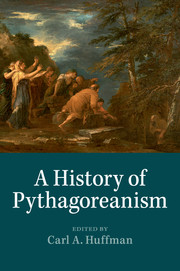Book contents
- Frontmatter
- Contents
- Contributors
- Abbreviations
- Introduction
- Chapter 1 Pythagoras
- Chapter 2 Philolaus
- Chapter 3 Archytas
- Chapter 4 Sixth-, fifth- and fourth-century Pythagoreans
- Chapter 5 The Pythagorean society and politics
- Chapter 6 The Pythagorean way of life and Pythagorean ethics
- Chapter 7 Pythagoreans, Orphism and Greek religion
- Chapter 8 The problem of Pythagorean mathematics
- Chapter 9 Pythagorean harmonics
- Chapter 10 The Pythagoreans and Plato
- Chapter 11 Aristotle on the “so-called Pythagoreans”: from lore to principles
- Chapter 12 Pythagoreanism in the Academic tradition: the Early Academy to Numenius
- Chapter 13 The Peripatetics on the Pythagoreans
- Chapter 14 Pythagoras in the historical tradition: from Herodotus to Diodorus Siculus
- Chapter 15 The pseudo-Pythagorean writings
- Chapter 16 Pythagoreans in Rome and Asia Minor around the turn of the common era
- Chapter 17 Diogenes Laertius’ Life of Pythagoras
- Chapter 18 Porphyry's Life of Pythagoras
- Chapter 19 Iamblichus’ On the Pythagorean Life in context
- Chapter 20 Pythagoras and Pythagoreanism in late antiquity and the Middle Ages
- Chapter 21 Pythagoras in the Early Renaissance
- Bibliography
- General index
- Index locorum
- Greek index
Chapter 12 - Pythagoreanism in the Academic tradition: the Early Academy to Numenius
Published online by Cambridge University Press: 05 May 2014
- Frontmatter
- Contents
- Contributors
- Abbreviations
- Introduction
- Chapter 1 Pythagoras
- Chapter 2 Philolaus
- Chapter 3 Archytas
- Chapter 4 Sixth-, fifth- and fourth-century Pythagoreans
- Chapter 5 The Pythagorean society and politics
- Chapter 6 The Pythagorean way of life and Pythagorean ethics
- Chapter 7 Pythagoreans, Orphism and Greek religion
- Chapter 8 The problem of Pythagorean mathematics
- Chapter 9 Pythagorean harmonics
- Chapter 10 The Pythagoreans and Plato
- Chapter 11 Aristotle on the “so-called Pythagoreans”: from lore to principles
- Chapter 12 Pythagoreanism in the Academic tradition: the Early Academy to Numenius
- Chapter 13 The Peripatetics on the Pythagoreans
- Chapter 14 Pythagoras in the historical tradition: from Herodotus to Diodorus Siculus
- Chapter 15 The pseudo-Pythagorean writings
- Chapter 16 Pythagoreans in Rome and Asia Minor around the turn of the common era
- Chapter 17 Diogenes Laertius’ Life of Pythagoras
- Chapter 18 Porphyry's Life of Pythagoras
- Chapter 19 Iamblichus’ On the Pythagorean Life in context
- Chapter 20 Pythagoras and Pythagoreanism in late antiquity and the Middle Ages
- Chapter 21 Pythagoras in the Early Renaissance
- Bibliography
- General index
- Index locorum
- Greek index
Summary
Introduction
Whatever may be said about Plato himself, there can be no doubt that Pythagoras and the Pythagorean tradition were major influences on his successors. Indeed, it may be claimed that the lineaments of what was to become the movement denominated in modern times “Neopythagoreanism” was given its impetus by the work of such figures in particular as Xenocrates and Heraclides of Pontus, though to a considerable extent also by Plato's immediate successor Speusippus. If we ask what are the salient characteristics of this intellectual movement or tendency in later Greco-Roman culture, I would propose the following: Neopythagoreanism is a branch of Platonism that emphasizes the role of number in the cosmos and which regards Pythagoreanism as the origin of this emphasis. Neopythagoreans thus show devotion to what they chose to regard as the basic principles of the Pythagorean philosophical system, the One and the Indefinite Dyad, although these principles are, in fact, Platonic. Neopythagoreans were Platonists and not themselves directly affiliated to anything that could be described as a Pythagorean “school,” although a few of them may also have followed to varying extents the Pythagorean way of life, or bios.
The Old Academy: Speusippus
If we turn first to Plato's nephew and successor Speusippus, we find, in his admittedly exiguous remains, some significant traces of “Neopythagoreanism.” His adoption of the One and Multiplicity (plēthos) as first principles need not be regarded as in itself “Pythagorean,” as it is simply an adaptation of Plato's “unwritten” doctrine of principles (itself, of course, indebted to the Pythagorean tradition), but in a passage preserved by Proclus in his Commentary on the Parmenides (Book 7 38.32–40.7 Klibansky), Speusippus attributes his system of first principles to “the ancients,” by which he undoubtedly means the Pythagoreans.
Keywords
- Type
- Chapter
- Information
- A History of Pythagoreanism , pp. 250 - 273Publisher: Cambridge University PressPrint publication year: 2014
- 7
- Cited by

